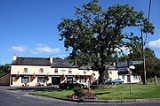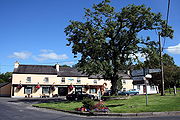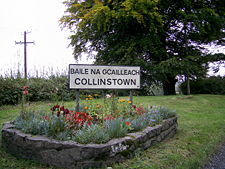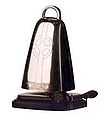
Collinstown
Encyclopedia
Collinstown is an expanding village in County Westmeath
, situated on the R395
regional road
18 km northeast of the county town of Mullingar
. Collinstown is in St Mary's (Roman Catholic) parish and has a population of approaching 700.

. Collinstown was known in the past as Maypole.
 Collinstown has been an inhabited area from pre-Christian times, as the presence of a number of Ringforts and other historic relics testifies. Though some are now overgrown they may be seen on the high ground surrounding Lough Lene. The area contains ancient burial-grounds associated with Saint Colman who was responsible for 7 early Christian cells, of which Lene and Carric are in the vicinity of Collinstown. Christian mass path
Collinstown has been an inhabited area from pre-Christian times, as the presence of a number of Ringforts and other historic relics testifies. Though some are now overgrown they may be seen on the high ground surrounding Lough Lene. The area contains ancient burial-grounds associated with Saint Colman who was responsible for 7 early Christian cells, of which Lene and Carric are in the vicinity of Collinstown. Christian mass path
s, and styles by which pilgrims travelled on foot through fields to Sunday mass date date from the penal times. Turgesius
the Viking had a fortress built nearby, upon the main Lough Lene Island. These and other historical relics are clearly marked on the Ordnance Survey of Ireland
(OSi) maps numbers 41 & 42.
West of Collinstown (in Ranaghan area, south-west of Lough Lene) are the remains of different ringforts. At least one of these is attributed to the Viking, Turgesius
. They were likely placed on the high ground overlooking the lake, for defensive purposes. Legend has it that Turgesius dwelled here before being killed by Máel Sechnaill mac Maíl Ruanaid
on Melaghlins instruction. In addition to this fort, Turgesius also had another upon the biggest island of Lough Lene which still today bears his name, Turgesius Island.
Collinstown also has historic links with several religious orders: the Irish name Baile na gCailleach is based on an association with the convent on the second island on Lough Lene. Nearby, to the north is the village of Fore
and the religious and monastic complex of Fore Abbey
.
was presented with the Bell of Lough Lene
by the Barbavila estate proprietor, Mr. William Barlow Smythe. The bell had been discovered in Lough Lene the previous year by a boy fishing for eels on Castle Island, which was owned by Smythe at the time.
 Given the close proximity to the Fore Abbey
Given the close proximity to the Fore Abbey
, the estate owner Smythe concluded that the bell possibly belonged to the St Feichin Abbey; During the Viking and Anglo-Norman oppressions, it may have been transferred to Nun's Island, before being eventually being hidden upon Castle Island.
The Bell
has a faint outline of the Christian Celtic cross
upon opposing sides and has an ornamental peripheral border. Smythe pronounced that ornamentation was generally reserved for the cases or shrine
s for that era and was therefore most unusual. The bell appears similar to two other bells from that early Christian period. These had been found in Bangor, County Down
in the year 1832, and another in Cashel, County Tipperary
in 1849.
Smythe, the Barbavila owner, believed that the Lough Lene Bell was contemporary to these other 7th century bells, supporting his theory that it was possible that it could have been a relic of St. Feichins. The Folklore Commission also hold an account of Kit "the Blade" Fagan's discovery of the bell, which consequentially triggered a local treasure hunt for further artifacts around Collinstown and Fore.
While the original Lough Lene Bell remains within the National Museum, a half sized replica holds a place of pride as the Ceann Comhairle
's Bell in Dáil Éireann
. This replica was presented to the Dáil in 1931 by the widow of Major Bryan Cooper, a former member of the House.
Barbavilla is now an industrial complex for automotive parts.
Co-ordinates: Latitude = 53.6357, Longitude = -7.2293
, wind-surfing, authorised fishing, and jetty facilities are available at the Collinstown lake access point named locally as "The Cut" about 2 km north of the village. The Pitch and putt
club of Collinstown is also popular.
Lough Lene Gaels
, the local hurling club, was founded in 1969 as a result of an amalgamation between the Collinstown, Fore
, Glenidan and Rickardstown hurling clubs. The club has enjoyed plenty of success since its formation and has won the Westmeath Senior Hurling Championship on seven occasions since 1975.
Also catering for GAA Sport in the area is Ballycomoyle GAA Club.
This Football Club caters for those who live in the Fore, Castlepollard or Collinstown area, and has teams to suit everyone.
Irish Aluminum Company situated in the Barbavilla Estate have made automotive parts for major European car companies, employing personnel locally.
Other local industries include Goats cheese production, electrical and plumbing
.
County Westmeath
-Economy:Westmeath has a strong agricultural economy. Initially, development occurred around the major market centres of Mullingar, Moate, and Kinnegad. Athlone developed due to its military significance, and its strategic location on the main Dublin–Galway route across the River Shannon. Mullingar...
, situated on the R395
R395 road
File:IMG_R395road2940.jpg|thumb|350px|left|R395 leaving Delvin poly 326 876 314 990 812 996 812 940 728 936 740 884 Edgeworthstownpoly 328 1016 314 1064 316 1120 828 1128 832 1074 736 1072 748 1020 Castlepollard...
regional road
Regional road
A regional road in Ireland is a class of road not forming a major route , but nevertheless forming a link in the national route network. There are over 11,600 kilometres of regional roads. Regional roads are numbered with three digit route numbers, prefixed by "R" A regional road in Ireland is a...
18 km northeast of the county town of Mullingar
Mullingar
Mullingar is the county town of County Westmeath in Ireland. The Counties of Meath and Westmeath Act of 1542, proclaimed Westmeath a county, separating it from Meath. Mullingar became the administrative centre for County Westmeath...
. Collinstown is in St Mary's (Roman Catholic) parish and has a population of approaching 700.

Name
The old Irish name of this village, translated means town of the veiled women. In the past the town was referred to irreverently as "the town of the hags" because there was once a convent established on the Nun's island of nearby Lough LeneLough Lene
Lough Lene is a lake situated in north County Westmeath, Ireland, between the villages of Castlepollard, Collinstown and Fore....
. Collinstown was known in the past as Maypole.
History

Mass path
A mass path is a pedestrian track or road connecting destinations frequently used by rural communities, most usually the destination of Sunday Mass. They were most common during the centuries that preceded motorised transportation in Western Europe, and in particular the British Isles; and the...
s, and styles by which pilgrims travelled on foot through fields to Sunday mass date date from the penal times. Turgesius
Turgesius
Turgesius was a Viking chief active in Ireland who is said to have conquered Dublin. It is not at all clear whether the names in the Irish annals represent the Old Norse Thurgestr or Thorgísl...
the Viking had a fortress built nearby, upon the main Lough Lene Island. These and other historical relics are clearly marked on the Ordnance Survey of Ireland
Ordnance Survey Ireland
Ordnance Survey Ireland is the national mapping agency of the Republic of Ireland and, together with the Ordnance Survey of Northern Ireland , succeeded, after 1922, the Irish operations of the United Kingdom Ordnance Survey. It is part of the Public service of the Republic of Ireland...
(OSi) maps numbers 41 & 42.
West of Collinstown (in Ranaghan area, south-west of Lough Lene) are the remains of different ringforts. At least one of these is attributed to the Viking, Turgesius
Turgesius
Turgesius was a Viking chief active in Ireland who is said to have conquered Dublin. It is not at all clear whether the names in the Irish annals represent the Old Norse Thurgestr or Thorgísl...
. They were likely placed on the high ground overlooking the lake, for defensive purposes. Legend has it that Turgesius dwelled here before being killed by Máel Sechnaill mac Maíl Ruanaid
Máel Sechnaill mac Maíl Ruanaid
Máel Sechnaill mac Máele Ruanaid was High King of Ireland. The Annals of Ulster use the Old Irish title rí hÉrenn uile, that is "king of all Ireland", when reporting his death, distinguishing Máel Sechnaill from the usual Kings of Tara who are only called High Kings of Ireland in late sources such...
on Melaghlins instruction. In addition to this fort, Turgesius also had another upon the biggest island of Lough Lene which still today bears his name, Turgesius Island.
Collinstown also has historic links with several religious orders: the Irish name Baile na gCailleach is based on an association with the convent on the second island on Lough Lene. Nearby, to the north is the village of Fore
Fore, County Westmeath
Fore is a village, next to the old Benedictine Abbey ruin of Fore Abbey, situated to the north of Lough Lene in County Westmeath, in Ireland....
and the religious and monastic complex of Fore Abbey
Fore Abbey
Fore Abbey is the old Benedictine Abbey ruin, situated to the north of Lough Lene in County Westmeath, Ireland.Fore village, is situated within a valley between two hills: the Hill of Ben, the Hill of Houndslow, and the Anchorland rise area...
.
The Lough Lene Bell
In 1882, the Royal Irish AcademyRoyal Irish Academy
The Royal Irish Academy , based in Dublin, is an all-Ireland, independent, academic body that promotes study and excellence in the sciences, humanities and social sciences. It is one of Ireland's premier learned societies and cultural institutions and currently has around 420 Members, elected in...
was presented with the Bell of Lough Lene
Lough Lene
Lough Lene is a lake situated in north County Westmeath, Ireland, between the villages of Castlepollard, Collinstown and Fore....
by the Barbavila estate proprietor, Mr. William Barlow Smythe. The bell had been discovered in Lough Lene the previous year by a boy fishing for eels on Castle Island, which was owned by Smythe at the time.

Fore Abbey
Fore Abbey is the old Benedictine Abbey ruin, situated to the north of Lough Lene in County Westmeath, Ireland.Fore village, is situated within a valley between two hills: the Hill of Ben, the Hill of Houndslow, and the Anchorland rise area...
, the estate owner Smythe concluded that the bell possibly belonged to the St Feichin Abbey; During the Viking and Anglo-Norman oppressions, it may have been transferred to Nun's Island, before being eventually being hidden upon Castle Island.
The Bell
Bell (instrument)
A bell is a simple sound-making device. The bell is a percussion instrument and an idiophone. Its form is usually a hollow, cup-shaped object, which resonates upon being struck...
has a faint outline of the Christian Celtic cross
Cross
A cross is a geometrical figure consisting of two lines or bars perpendicular to each other, dividing one or two of the lines in half. The lines usually run vertically and horizontally; if they run obliquely, the design is technically termed a saltire, although the arms of a saltire need not meet...
upon opposing sides and has an ornamental peripheral border. Smythe pronounced that ornamentation was generally reserved for the cases or shrine
Shrine
A shrine is a holy or sacred place, which is dedicated to a specific deity, ancestor, hero, martyr, saint, daemon or similar figure of awe and respect, at which they are venerated or worshipped. Shrines often contain idols, relics, or other such objects associated with the figure being venerated....
s for that era and was therefore most unusual. The bell appears similar to two other bells from that early Christian period. These had been found in Bangor, County Down
Bangor, County Down
Bangor is a large town in County Down, Northern Ireland. It is a seaside resort on the southern side of Belfast Lough and within the Belfast Metropolitan Area. Bangor Marina is one of the largest in Ireland, and holds Blue Flag status...
in the year 1832, and another in Cashel, County Tipperary
Cashel, County Tipperary
Cashel is a town in South Tipperary in Ireland. Its population was 2936 at the 2006 census. The town gives its name to the ecclesiastical province of Cashel. Additionally, the cathedra of the Roman Catholic Archdiocese of Cashel and Emly was originally in the town prior to the English Reformation....
in 1849.
Smythe, the Barbavila owner, believed that the Lough Lene Bell was contemporary to these other 7th century bells, supporting his theory that it was possible that it could have been a relic of St. Feichins. The Folklore Commission also hold an account of Kit "the Blade" Fagan's discovery of the bell, which consequentially triggered a local treasure hunt for further artifacts around Collinstown and Fore.
While the original Lough Lene Bell remains within the National Museum, a half sized replica holds a place of pride as the Ceann Comhairle
Ceann Comhairle
The Ceann Comhairle is the chairman of Dáil Éireann, the lower house of the Oireachtas of Ireland. The person who holds the position is elected by members of the Dáil from among their number in the first session after each general election...
's Bell in Dáil Éireann
Dáil Éireann
Dáil Éireann is the lower house, but principal chamber, of the Oireachtas , which also includes the President of Ireland and Seanad Éireann . It is directly elected at least once in every five years under the system of proportional representation by means of the single transferable vote...
. This replica was presented to the Dáil in 1931 by the widow of Major Bryan Cooper, a former member of the House.
Barbavila Manor
During the last century, the Barbavila House & Estate provided employment in the area. Houses, farm buildings, and animal dwellings were built from stone for employees throughout the immediate surroundings of Barbavilla in and around Collinstown. These stone houses, the old school, and farm buildings are protected through local heritage conservation laws. The notable feature of these buildings of stone is the roofing tile baked from local red coloured clay, which was manufactured within the Barbavilla estate. Some of these remaining buildings are identified by the small moss-green circles.Barbavilla is now an industrial complex for automotive parts.
Co-ordinates: Latitude = 53.6357, Longitude = -7.2293
Sport activities
Bathing, SailingSailing
Sailing is the propulsion of a vehicle and the control of its movement with large foils called sails. By changing the rigging, rudder, and sometimes the keel or centre board, a sailor manages the force of the wind on the sails in order to move the boat relative to its surrounding medium and...
, wind-surfing, authorised fishing, and jetty facilities are available at the Collinstown lake access point named locally as "The Cut" about 2 km north of the village. The Pitch and putt
Pitch and putt
Pitch and putt is an amateur sport, similar to golf. The maximum hole length for international competitions is with a maximum total course length of . Players may only use three clubs; one of which must be a putter...
club of Collinstown is also popular.
Lough Lene Gaels
Lough Lene Gaels
Lough Lene Gaels is a Gaelic Athletic Association club, based in Collinstown, County Westmeath, Ireland.-Club history:...
, the local hurling club, was founded in 1969 as a result of an amalgamation between the Collinstown, Fore
Fore, County Westmeath
Fore is a village, next to the old Benedictine Abbey ruin of Fore Abbey, situated to the north of Lough Lene in County Westmeath, in Ireland....
, Glenidan and Rickardstown hurling clubs. The club has enjoyed plenty of success since its formation and has won the Westmeath Senior Hurling Championship on seven occasions since 1975.
Also catering for GAA Sport in the area is Ballycomoyle GAA Club.
This Football Club caters for those who live in the Fore, Castlepollard or Collinstown area, and has teams to suit everyone.
Commerce & industry
Since 1964, the IRALCOIrish Aluminium Company
-IRALCO:Iralco, Irish Aluminium Company, is situated in Collinstown, North Westmeath. The company is one of the longest-established manufacturers in Ireland and was initially established in 1964. It produces components from some of Europe's best-known car manufacturers, including Audi, BMW, Ford,...
Irish Aluminum Company situated in the Barbavilla Estate have made automotive parts for major European car companies, employing personnel locally.
Other local industries include Goats cheese production, electrical and plumbing
Plumbing
Plumbing is the system of pipes and drains installed in a building for the distribution of potable drinking water and the removal of waterborne wastes, and the skilled trade of working with pipes, tubing and plumbing fixtures in such systems. A plumber is someone who installs or repairs piping...
.
See also
- List of towns and villages in Ireland
External links
- Lough Lene Communities
- Westmeath County Council
- Gleann Álainn Residents Association Collinstown
- Viking Ireland Network school project
- Lough Lene "Monk's boat"
- Lough Lene Gaels
- Ballycomoyle GAA Club
- St. Colman (Colman Mac Luachain 6th/7th century)
- Betha Colmáin Maic Lúacháin, or, The Life of Colmán son of Lúachan
- Collinstown
- The family and estate papers of the Smythe family of Barbavilla, Collinstown, 1621 - 1930. Collection List No. 120 at the National Library of Ireland

